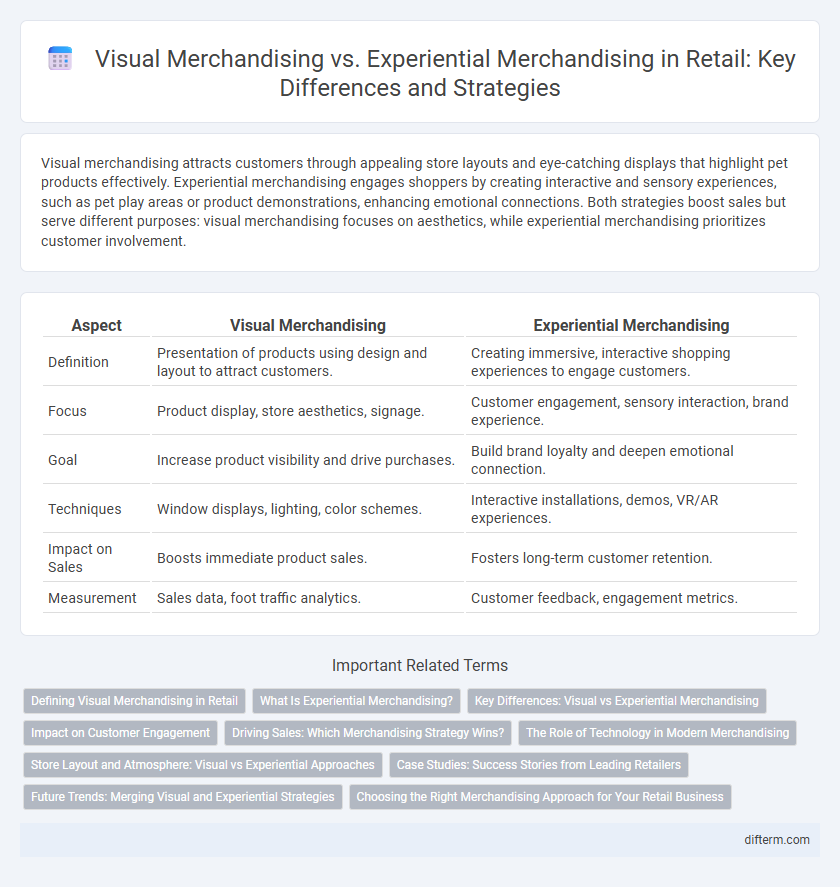Visual merchandising attracts customers through appealing store layouts and eye-catching displays that highlight pet products effectively. Experiential merchandising engages shoppers by creating interactive and sensory experiences, such as pet play areas or product demonstrations, enhancing emotional connections. Both strategies boost sales but serve different purposes: visual merchandising focuses on aesthetics, while experiential merchandising prioritizes customer involvement.
Table of Comparison
| Aspect | Visual Merchandising | Experiential Merchandising |
|---|---|---|
| Definition | Presentation of products using design and layout to attract customers. | Creating immersive, interactive shopping experiences to engage customers. |
| Focus | Product display, store aesthetics, signage. | Customer engagement, sensory interaction, brand experience. |
| Goal | Increase product visibility and drive purchases. | Build brand loyalty and deepen emotional connection. |
| Techniques | Window displays, lighting, color schemes. | Interactive installations, demos, VR/AR experiences. |
| Impact on Sales | Boosts immediate product sales. | Fosters long-term customer retention. |
| Measurement | Sales data, foot traffic analytics. | Customer feedback, engagement metrics. |
Defining Visual Merchandising in Retail
Visual merchandising in retail focuses on strategically designing store layouts, displays, and product placements to attract customers and enhance the shopping experience. It involves the use of color, lighting, signage, and props to create visually appealing environments that highlight products and influence buying behavior. Effective visual merchandising increases foot traffic, promotes brand identity, and drives sales by making merchandise accessible and engaging.
What Is Experiential Merchandising?
Experiential merchandising transforms retail spaces into interactive environments that engage customers through multisensory experiences, fostering emotional connections with the brand. Unlike traditional visual merchandising, which emphasizes product display and aesthetics, experiential merchandising integrates storytelling, technology, and personalized interactions to enhance customer involvement. This approach drives higher customer satisfaction, increased dwell time, and stronger brand loyalty by making shopping memorable and immersive.
Key Differences: Visual vs Experiential Merchandising
Visual merchandising focuses on creating appealing store displays and product arrangements to attract customers' attention and drive sales, emphasizing aesthetics, layout, and signage. Experiential merchandising goes beyond visuals by engaging customers through interactive elements, sensory experiences, and immersive environments to build emotional connections and enhance brand loyalty. The key difference lies in visual merchandising's goal of showcasing products effectively, while experiential merchandising aims to create memorable, hands-on experiences that influence purchasing behavior.
Impact on Customer Engagement
Visual merchandising utilizes strategically arranged displays, lighting, and color to attract customer attention and enhance product visibility, driving impulse purchases. Experiential merchandising creates immersive brand interactions and sensory experiences, fostering deeper emotional connections and increasing time spent in-store. Both methods significantly boost customer engagement but experiential merchandising tends to generate higher brand loyalty through personalized and memorable experiences.
Driving Sales: Which Merchandising Strategy Wins?
Visual merchandising leverages strategic product placement, lighting, and signage to attract customers and boost impulse buying, directly impacting sales through enhanced store aesthetics. Experiential merchandising, by creating immersive brand interactions and sensory experiences, fosters emotional connections that drive customer loyalty and increase purchase frequency. Data shows experiential merchandising can yield up to 15% higher sales growth by transforming shopping into memorable events, making it a powerful strategy for sustained revenue.
The Role of Technology in Modern Merchandising
Technology transforms visual merchandising through digital signage, augmented reality (AR), and interactive displays that enhance product presentation and customer engagement. Experiential merchandising leverages virtual reality (VR) and mobile apps to create immersive shopping environments, driving emotional connections and increasing dwell time. Data analytics and AI optimize both strategies by personalizing experiences and adjusting merchandising tactics based on consumer behavior insights.
Store Layout and Atmosphere: Visual vs Experiential Approaches
Visual merchandising emphasizes strategic store layouts that highlight product displays through lighting, color schemes, and signage to attract customer attention and drive sales. Experiential merchandising prioritizes creating immersive atmospheres by integrating sensory elements, interactive displays, and thematic designs that engage customers emotionally and encourage longer in-store visits. Both approaches shape store environment but differ in visual appeal versus multi-sensory engagement for optimizing customer experience and behavior.
Case Studies: Success Stories from Leading Retailers
Leading retailers like Nike and Apple showcase the power of experiential merchandising through immersive store designs that boost customer engagement and sales. Visual merchandising remains crucial for brands like Zara, where strategic product displays and window designs drive foot traffic and immediate purchases. Combining both strategies, brands such as Sephora create environments that encourage interaction with products while maintaining visually appealing layouts, resulting in increased conversion rates and brand loyalty.
Future Trends: Merging Visual and Experiential Strategies
Future trends in retail emphasize the integration of visual merchandising with experiential merchandising to create immersive, multi-sensory shopping environments that engage customers on deeper emotional and cognitive levels. Advanced technologies such as augmented reality (AR), virtual reality (VR), and AI-driven personalization are being leveraged to blend dynamic visual displays with interactive experiences, driving higher customer engagement, dwell time, and conversion rates. Retailers investing in unified strategies that combine aesthetic appeal with interactive elements will shape the future of retail space design and consumer interaction.
Choosing the Right Merchandising Approach for Your Retail Business
Visual merchandising enhances product appeal through strategic displays and store layout, driving immediate customer interest and boosting sales. Experiential merchandising focuses on creating immersive, interactive environments that foster emotional connections and brand loyalty. Selecting the right approach depends on your target market's preferences, store size, and long-term business goals to maximize engagement and profitability.
Visual Merchandising vs Experiential Merchandising Infographic

 difterm.com
difterm.com